|
Week 11: October 10 - 16, 2011 |
Welcome
to the McGill Bird Observatory weekly report.
Click here for a complete listing of our archives.
Comments or
questions are welcome at "mbo AT migrationresearch.org".
|
PICTURE
OF THE WEEK: |
|
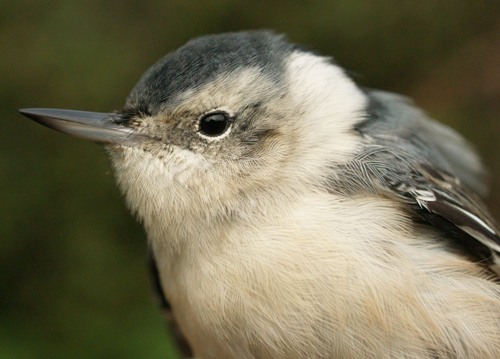
This week's highlight was this female White-breasted Nuthatch, a resident species
at MBO, but just the 6th individual banded in 7 years, and the first since 2009.
(Photo by Simon Duval)
|
|
|
THIS WEEK |
THIS FALL |
2011 TOTAL |
SITE TOTAL |
|
# birds (and species) banded |
104 (18) |
2504 (74) |
3592 (84) |
35161 (108) |
|
# birds (and species) repeat |
36 (12) |
514 (45) |
669 (48) |
6176 (68) |
|
# birds (and species) return |
2 (2) |
32 (9) |
127 (21) |
934 (37) |
|
# species observed |
52 |
140 |
159 |
204 |
|
# net hours |
307.0 |
5369.1 |
8206.1 |
57823.2 |
|
# birds banded / 100 net hours |
33.9 |
46.6 |
43.8 |
60.8 |
|
|
Note: table does not include nocturnal banding (owls) |
|
Banders-in-charge: Bob Barnhurst, Simon Duval, Gay Gruner
Assistants: Sue Bishop, Lindsay Burkhart, Stephanie Cote, David Davey, Rui De Jesus, Jean Demers, Réjean Duval, Nicki Fleming, Barbara Frei, Alison Hackney, Lima Kayello, Barbara MacDuff, Betsy McFarlane, Chris Murphy, Charles Reznier, Ahmad Shah, Clémence Soulard, Alexandra Summer, Elise Titman, Rodger Titman, Matthew Von Bornhoft, Tim Zarins
Notes: After the last couple of weeks, we were resigned to it being a quiet fall at MBO, but even so, we were shocked at how few birds we were able to band this week. The total of 104 was barely more than half of our previous low for week 11, and far below our six-year average of 380 for this period. Weather was again a factor this week, with Friday and Saturday entirely rained out, and banding effort curtailed on three other days. However, the birds simply weren't around in good numbers - our rate of 33 birds banded per 100 net hours wasn't even half of the low end of the range of 77 to 147 during week 11 in previous years. Especially after last year's relentless flow of October migrants, it seemed eerily quiet most mornings this week.
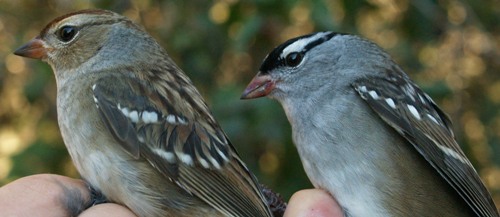
White-crowned Sparrow is one of the species that has been unusually scarce this fall, with only 14 banded to date, compared to previous season totals of 20 to 80. However, we did at least catch a hatch-year and after-hatch-year bird together at one point for this nice side-by-side comparison.
(Photo by Simon Duval)
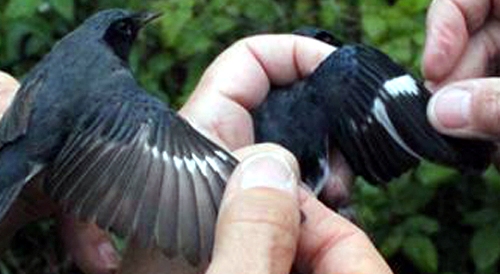
Another nice comparison was provided by these two male Black-throated Blue Warblers, a hatch-year bird on the left, and a much more boldly marked after-hatch-year bird on the right.
(Photo by Matthew Von Bornhoft)
|
For the past couple of weeks, banding totals were below average but the diversity of species on site was at record levels. This week our luck ran out in that regard too, with the count of 52 species being the lowest ever for week 11, the previous range being 55 to 68. However, we did increase the season total to 140 (which matchese the previous high at this point in fall) thanks to our first sightings of Cackling Goose and Golden Eagle for the year, and this fall's first Green-winged Teal and Great Egret (surprisingly late in the season). The only new species banded this week was White-breasted Nuthatch, a first for both the season and the year.
This week’s top 10 [last year's rank for this week in brackets]
# individuals banded |
mean # individuals observed daily |
1. Yellow-rumped Warbler (30) [3] |
1. Canada Goose (306) [1] |
2. White-throated Sparrow (21) [1] |
2. Red-winged Blackbird (219) [2] |
3. Ruby-crowned Kinglet (11) [2] |
3. American Robin (87) [3] |
4. Slate-colored Junco (9) [9] |
4. American Crow (37) [4] |
5. Hermit Thrush (8) [5] |
5. Blue Jay (27) [7] |
6. Song Sparrow (5) [6] |
6. White-throated Sparrow (21) [5] |
6. Swamp Sparrow (5) [-] |
7. European Starling (19) [-] |
8. Blue Jay (2) [-] |
8. Black-capped Chickadee (12) [8] |
8. Black-capped Chickadee (2) [-] |
9. Pine Siskin (11) [6] |
10. 9 species (1) [-]
|
10. Yellow-rumped Warbler (8) [10]
|
|
This was the second quietest week in the history of MBO's Fall Migration Monitoring Program, beating out only the final week of 2006 when we banded just 94 birds. We couldn't even cobble together a 'proper' top ten this week, as we had a nine-way tie for tenth place, with a single bird banded each. For a third week in a row the top three species shuffled positions amongst themselves, and in a bit of a surprise Yellow-rumped Warbler ended up on top. This was unexpected since Yellow-rumped Warblers have overall followed the now expected two-year cycle, with 108 banded to date this year, remarkably close to the previous "odd-year" average of 110, but far below the "even-year" average of 1538 ... yet in the previous odd years, Yellow-rumped Warbler only cracked the top ten once during week 11, and that was with a total of just 12 birds. Clearly there is no end to the surprises this fall. Perhaps most noteworthy about this week's list is the absence of American Robin. Technically it's on the list by virtue of being one of the nine species tied for tenth place - but the fewest we've ever banded in week 11 in previous years is 34 in 2005, and our six-year average for this week is 68! Also unusually scarce was Slate-colored Junco, with 9 banded compared to a six-year average of 54. On the other hand, we banded more Swamp Sparrows than any other week this fall.
Canada Goose remained the top species observed, for the seventh week in a row. Whereas weeks 9 and 10 have been dominated by the geese every year, American Robin has been the top species in week 11 in four of our previous six years, and second to Canada Goose in the other two. While the number of American Robins observed wasn't as far below normal as the number banded, the mean daily count of 87 this week was still a significant departure from our average of 356 during week 11 in previous years. Our top four this week remained unchanged in rank compared to last week, and most of the rest of the list was only shuffled slightly. The only new addition was European Starling in seventh position, displacing Ruby-crowned Kinglet.
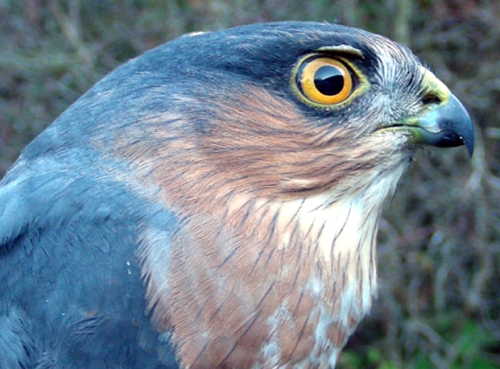
This week we banded our fifth Sharp-shinned Hawk of the fall, and for once it was an after-hatch-year bird (the vast majority of our raptor captures are hatch-year individuals)
(Photos by
Gay Gruner)
|
On the owling front, the week began on a high note, with 14 more saw-whets banded, and another two foreign recaptures, in this case banded in Virginia and Massachusetts, both of them in 2010. Given that over previous years our busiest nights for owling have on average been October 11 to 13, we had high expectations. Remarkably though, we were shut out for three nights in a row during that period! This underlines just how sensitive saw-whets appear to be to weather conditions. Those three days were unseasonably warm, with highs of 17 or 18 Celsius daily, and lows as warm as 12. We rarely catch more than an occasional straggler when temperatures are in the double digits, probably a reflection of the owls moving along with cold fronts and waiting for these warm air masses from the south to be pushed back south. Friday was even warmer, but then got rained out in the evening, and we also lost Saturday to weather. In limited operation on Sunday night we got one owl, bringing the total for the week to 15, plus two foreign recaps, and the season total to 92 plus 4 foreigners.
|
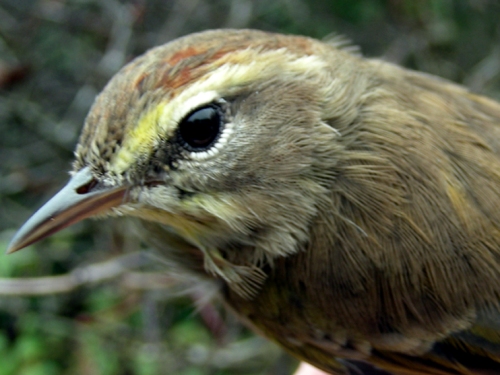
It was our poorest fall count ever for Palm Warblers, with only 7 individuals banded, but we did at least have a chance to compare Yellow Palm Warbler (above) and Western Palm Warbler (below).
(Photos by
Gay Gruner)
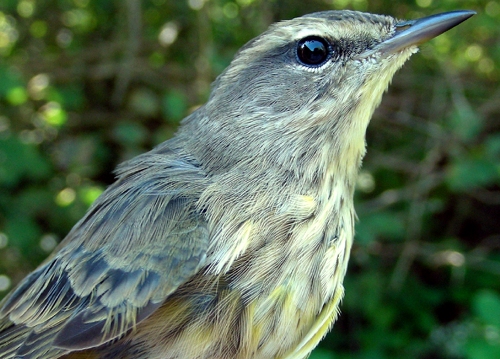
|






